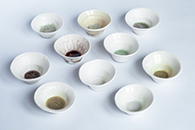
-

The evolution of human culture is closely intertwined with craftsmanship, its techniques, and the choice of materials. For many centuries, the resources that humans used for making tools, clothing, and everyday items were of invaluable worth. Craftsmanship that wasted no material was regarded as a sign of high quality and virtue.
-

The relations between human and animal camouflage have rarely been investigated. Current scholarship, focusing on the evolutionary and military aspects of camouflage, has overshadowed earlier thinking about camouflage and mimicry as shared animal and human features. Reconstructing some of the main elements of those early views, this article argues that, in humans, camouflage should be considered as a cultural technique.
-

To be lost and found at sea: What kinds of thinking does the shipwreck prompt? This essay pursues this question by centering fragmented remains—large beeswax blocks and Chinese porcelain ware—from the Santo Cristo de Burgos, a Spanish galleon lost while traveling from Manila to Acapulco at the end of the seventeenth century.
-

By recording the physical evidence of metal’s molten transition between forms, gold and silver ingots offer a material foothold on the metaphors of liquidity and flow used to conceptualize the global circulation of precious metal in premodernity.
-

A copper ingot found in Cyprus signifies both the beginning and the end of life for many items of metalwork.
-

This article reconstructs the process through which Chinese dress objects transferred from wearing to display, and the collectors, curators, and dealers responsible.
-

My grandfather must have bought me the Junior School Dictionary soon after it was published, because my mother and I left India in 1982. I imagine carting this volume across the oceans, from Madras (it was still called Madras then) to Bethesda, Maryland…
-

This essay explores the significance of a corpus of square-based, mold-blown, and gilded glass vessels that were made in India in the seventeenth and eighteenth centuries and have been cast under the wider rubric of “Mughal glass.”
-

Color Reproductions of Mexican Frescoes by Diego Rivera was a relatively small MoMA exhibition that has been largely overlooked by scholars of modern art and design.
-

Treating writing as a “cultural technique,” this article investigates writing in material culture in Arabia from the sixth to the eighth century CE to show that practices such as writing on shoes reflect a deliberate prioritization of the materiality of writing over its semantic content.
-

An examination of the display and treatment by the British of the Koh-i-Noor diamond with an emphasis on the feminization of the jewel, the Indian subcontinent, and Queen Victoria herself.
-

This article brings together for the first time all archival and material evidence detailing the history and appearance of three little-known works of neoclassical chinoiserie by Robert Adam.
-

Understanding the Viennese artist Hans Makart’s studio requires looking beyond style to matters of science and commerce, subjectivity and power.
-

Since the middle of the nineteenth century, archaeology has been firmly established as a specific way of exploring the past. So where, then, is the dividing line between history and archaeology?
-

Examining the development of a specific gendered discourse driven by the electrical industry that united key beliefs about feminine beauty, identity, and the domestic interior.
-

Within the framework of an overall theory of the cultural history of materials, this article reconstructs the role of tempered glass in the modernist imagination.
-

What does Lauren Conrad have in common with Rimsha Masih? One is an American reality TV star who parlayed her MTV persona into a do-it-yourself website, a fashion line, and several semiautobio-
graphical novels; the other is an illiterate Pakistani Christian. -

How does one portray the human subject of speed? Both in terms of able bodies and quick wits?
-

What does it mean to “replace the government of persons by the administration of things?” And what do we do about all this paperwork?
-

This article considers the relationship between self-conscious cultural reawakening in early Pahlavi Iran and the cotemporaneous vogue for Persian art and aesthetics in the United States.
-

The Last Connoisseur: “We are dinosaurs left over from an epoch whose participants are mostly dead. There is no one to take our place.”
-

What do art history and material culture studies have in common? Why have the two been so poorly integrated with each other? Should art-historical practices play a greater role in the examination of the social lives of objects?
-

We have come full circle in a world built around performance as flow; a world in which spinning disks signify sampling, mixing, busting moves and rhymes and singing songs; a world in which the pulse of the ideal life is a synthetic drum track.
-

Clothing’s portability grants it a history of embodiment and transmutation, moving among bodies, cultures, nations, and economies.
-

“Machines should work — people should think — machines — should work — people — should think — machines — should — work — people — should — think.”
-

Putting mater (and pater) back in materialism. Roland Barthes’s take on writing, paperwork, the materiality of communication, and its unconscious dimensions.
-

How important is it to understand the method by which an object comes into being? What does knowledge of these methods reveal about the object itself?
-

A major evaluation of one of the most visually productive collaborations in the history of cinema.
Featured articles will be updated regularly. Full issues are published by the University of Chicago Press, and can be accessed here.
Subscribe or Renew
